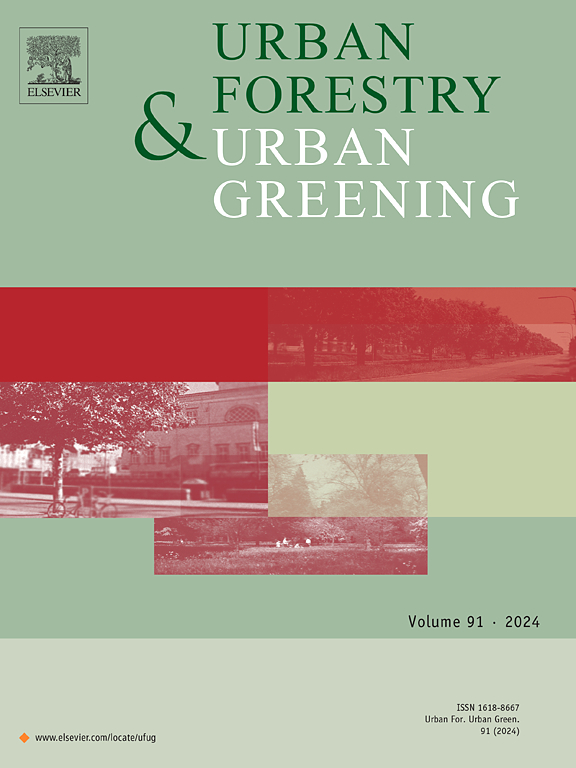High respiration rates induce net CO2 emissions in an urban allotment garden in Finland
IF 6
2区 环境科学与生态学
Q1 ENVIRONMENTAL STUDIES
引用次数: 0
Abstract
The carbon balance in urban allotment gardens remains poorly quantified. We assessed the carbon dioxide (CO2) balance in an allotment garden in southern Finland using the eddy covariance method (EC) and soil chamber measurements. The year-round EC measurement showed that despite of 77 % vegetation cover, this ecosystem functioned as a net CO₂ source (0.69 kg m⁻²yr⁻¹). This resulted from high respiratory emissions (4.7 kg m⁻²yr⁻¹) exceeding substantial photosynthetic uptake (4.0 kg m⁻²yr⁻¹). This respiratory surplus was likely linked to elevated soil organic carbon (13.4 ± 8.7 %) and high soil C:N ratio originating from management amendments. While vegetation density enhanced photosynthesis in certain sectors within the garden, proportionally high respiration in the same sectors cancelled out any major net carbon uptake differences across the garden. These case-specific findings challenge assumptions about urban gardens as inherent carbon sinks and highlight that carbon-smart management practices may be needed to enhance carbon uptake and reduce emissions in urban gardens.
在芬兰的一个城市分配花园中,高呼吸率导致净二氧化碳排放
城市分配花园的碳平衡仍然缺乏量化。我们利用涡旋相关方差法(EC)和土壤室测量评估了芬兰南部一个分配花园的二氧化碳(CO2)平衡。全年的EC测量表明,尽管植被覆盖率为77 %,但该生态系统的净CO₂源(0.69 kg m⁻²yr⁻¹)。这是由于大量的呼吸排放物(4.7 kg m⁻²yr⁻¹)超过了大量的光合作用吸收(4.0 kg m⁻²yr⁻¹)。这种呼吸过剩可能与土壤有机碳升高(13.4 ± 8.7 %)和管理修正导致的土壤碳氮比升高有关。虽然植被密度增强了花园里某些区域的光合作用,但相同区域的高呼吸比例抵消了花园里任何主要的净碳吸收差异。这些针对具体案例的研究结果挑战了关于城市花园是固有碳汇的假设,并强调可能需要碳智能管理实践来增强城市花园的碳吸收和减少排放。
本文章由计算机程序翻译,如有差异,请以英文原文为准。
求助全文
约1分钟内获得全文
求助全文
来源期刊

Urban Forestry & Urban Greening
FORESTRY-
CiteScore
11.70
自引率
12.50%
发文量
289
审稿时长
70 days
期刊介绍:
Urban Forestry and Urban Greening is a refereed, international journal aimed at presenting high-quality research with urban and peri-urban woody and non-woody vegetation and its use, planning, design, establishment and management as its main topics. Urban Forestry and Urban Greening concentrates on all tree-dominated (as joint together in the urban forest) as well as other green resources in and around urban areas, such as woodlands, public and private urban parks and gardens, urban nature areas, street tree and square plantations, botanical gardens and cemeteries.
The journal welcomes basic and applied research papers, as well as review papers and short communications. Contributions should focus on one or more of the following aspects:
-Form and functions of urban forests and other vegetation, including aspects of urban ecology.
-Policy-making, planning and design related to urban forests and other vegetation.
-Selection and establishment of tree resources and other vegetation for urban environments.
-Management of urban forests and other vegetation.
Original contributions of a high academic standard are invited from a wide range of disciplines and fields, including forestry, biology, horticulture, arboriculture, landscape ecology, pathology, soil science, hydrology, landscape architecture, landscape planning, urban planning and design, economics, sociology, environmental psychology, public health, and education.
 求助内容:
求助内容: 应助结果提醒方式:
应助结果提醒方式:


